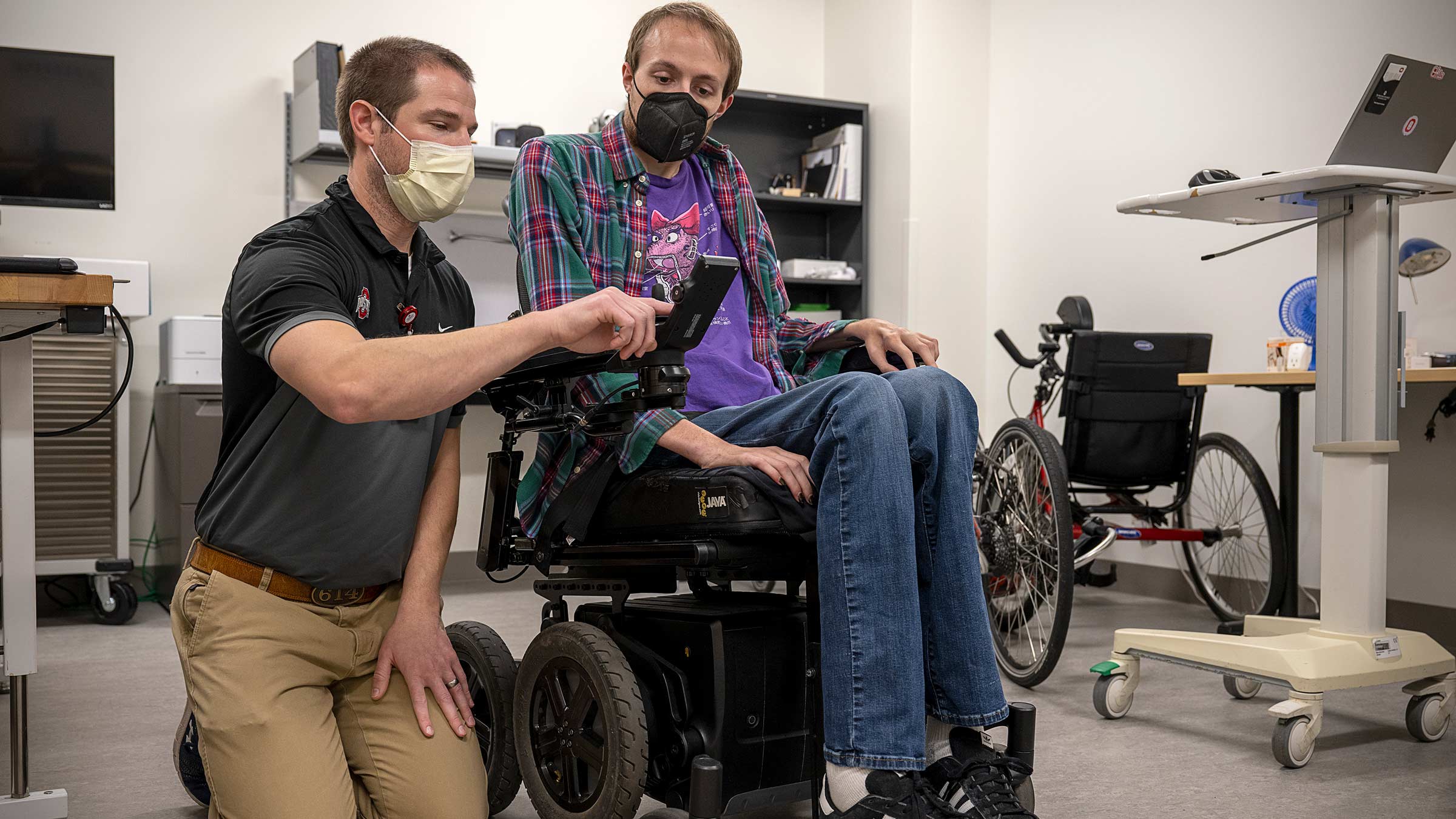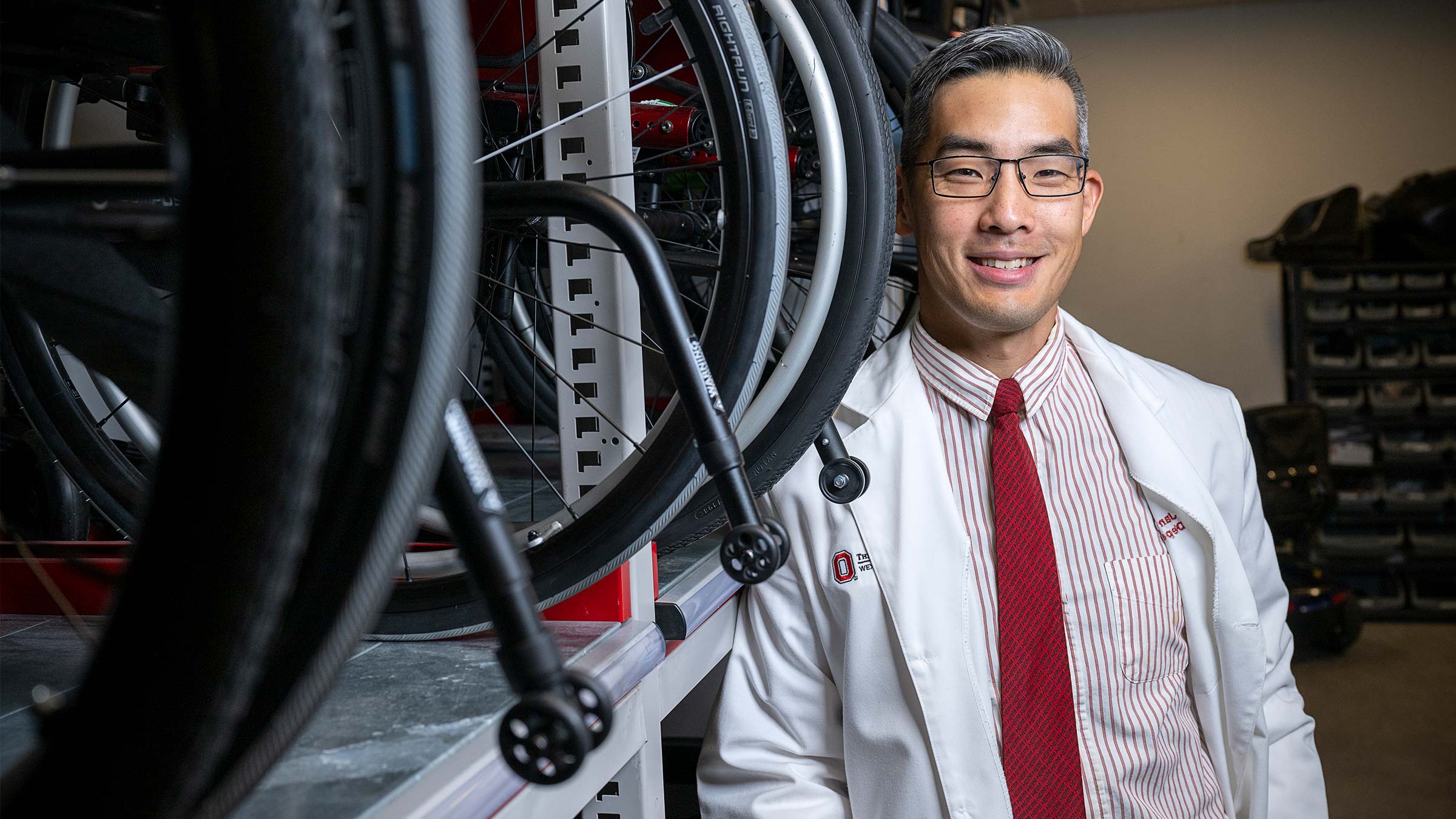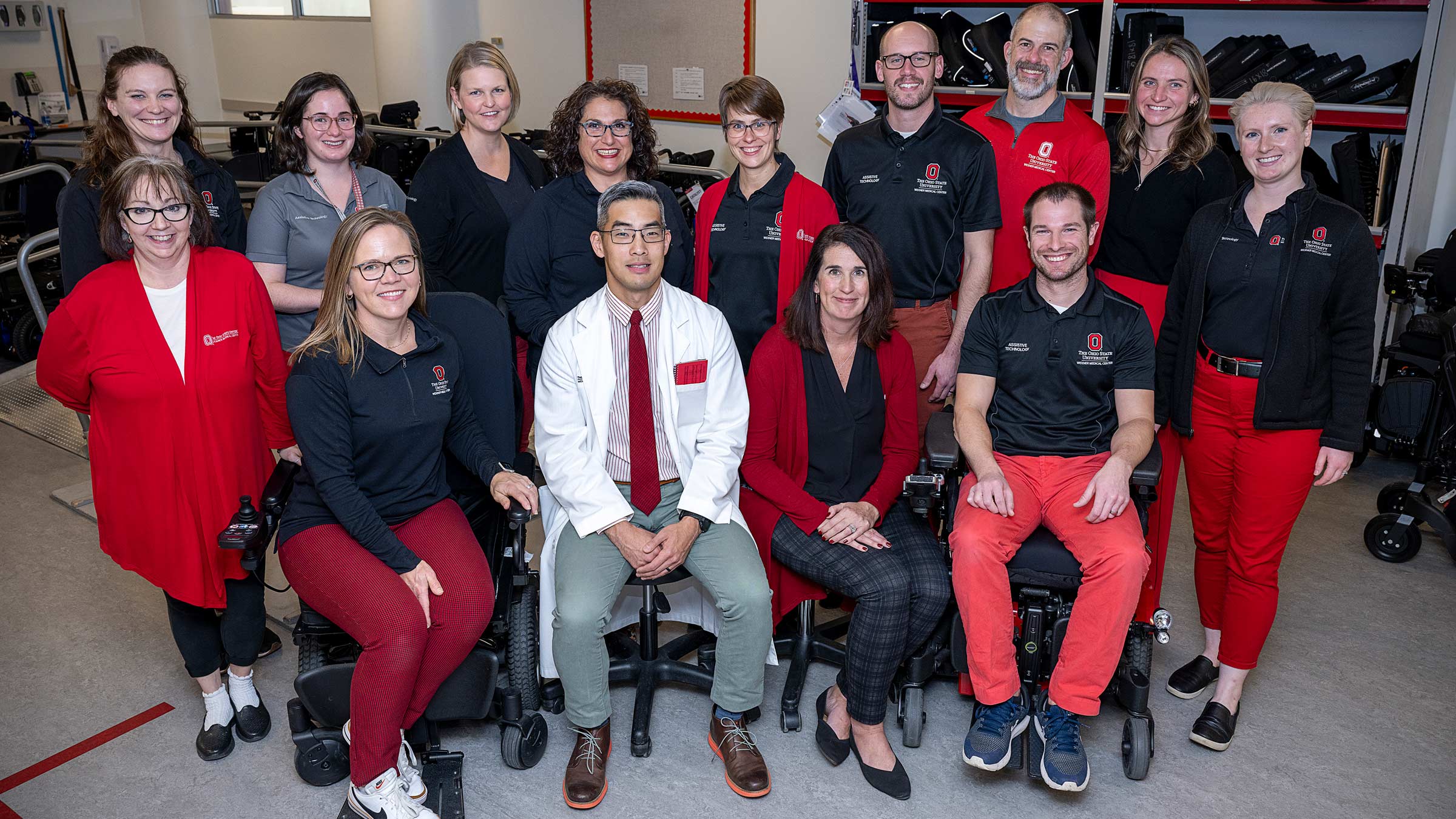
Before settling on medical school, Daniel Kim, MD, had toyed with the idea of becoming an engineer.
While his career path took a different turn, he uses engineering skills each day as one of the only physicians in the nation to serve patients full time in a mobility clinic. He spends his days at The Ohio State University Wexner Medical Center’s Martha Morehouse Outpatient Care facility seeing to the needs of people who use wheelchairs and other devices to get from one place to another.
The role is a perfect fit for Dr. Kim, medical director of the Assistive Technology Center, which houses the program for the Wheelchair Seating and Mobility Clinic.
“I really enjoy breaking down things that are mechanical. If it has a motor on it, I’m interested in it,” Dr. Kim says.
“So, stepping into the Assistive Technology Center for the first time, I just kind of felt like I was at home.”
His goal is to find solutions for patients who may have lived for years with limited mobility or devices that cause them pain or aggravation.
Along with Dr. Kim’s expertise, patients also benefit from the center’s vast inventory of walkers, manual and motorized wheelchairs and scooters that specially trained therapists and patients can take on trial runs before making a final determination on which is the best option.

Rehabilitation clinical manager Theresa Berner, MOT, OTR/L, ATP, says 14 therapists, most with advanced certification in assistive technology, focus their primary caseload on wheelchair seating in collaboration with Dr. Kim. They work in tandem with technicians and complex rehabilitation suppliers to help patients select the ideal mobility equipment.
Then, when personal devices are ordered and arrive, they ensure patients have a comfortable fit and know how to best operate them. The team follows the patients from evaluation to delivery and continues to follow them on a regular basis to offer adjustments and modifications to fit their needs.
“It’s kind of like a playground of equipment that we have here,” Berner says.
“We have the ability to offer that full spectrum — we do the evaluation, we do the trial and then we fit them into their chair. And then, if they need modifications and problem solving, we are available to support any necessary changes.”
Having such an array of models is unique, and it allows the therapists to become specialized in a wide range of devices as well as related accessories, including wheelchair controls, cushions, arm rests and footrests, all of which can be customized. Space for testing short distances, curbs, raised curves and inclines allows patients to get a good sense of how the devices will feel and perform in real life.
The center is a place where patients have access to cutting-edge technology and the people who can teach others how to use it. For example, since August 2022, it’s been one of two centers in the country certified to train patients to use the stair-climbing Mobius Mobility iBOT wheelchair.
Patient Gabe Jones recently traveled from southern Indiana for an evaluation on a demo iBOT and was able to try various modes of operation and test the device both indoors and outside.
Jones has primarily been using a power wheelchair since having a blood clot in his spinal cord in 2003, when he was 14. He expects to eventually purchase his own iBOT to use as his primary chair, allowing him to go to places he previously couldn’t visit and navigate curbed crosswalks and rougher terrain.
When Jones’ personal chair arrives, physical therapist Matt Linsenmayer, PT, DPT, ATP, will ensure he receives intensive training so he’s able to safely and comfortably use it as his daily mobility device. Linsenmayer will also support Jones for any future needs with the device.
Mobility devices changing lives
The clinic is open to people of all ages who have issues related to mobility impairment for any reason, from something as simple as an arthritic knee to something as complex as a rare, genetic muscular dystrophy. They all have different needs, as well as activities they’d like to be able to perform, and the versatile team at the clinic is able to address concerns for whoever comes in.
“We really believe that everybody, no matter who you are, should have the ability to be mobile, if at all possible, in a safe, independent and pain-free way,” Dr. Kim says.
“What we often find is, folks have kind of settled for whatever predicament they’re in. And they don’t understand, necessarily, and physicians don’t necessarily understand, that there are certain pieces of equipment or devices or technology that can restore a lot of that mobility and independence and safety and comfort.”
Dr. Kim is board certified in physical medicine and rehabilitation, but he notes that much of his training is self-taught because the program is so unusual — despite the need being so great.
“I would say I can’t really see myself doing anything else at this point,” he says. “I think the outcomes that we see are oftentimes life-changing.”
This can be especially evident for people who have had mobility deficits since birth and who also have communication deficits. Often, he says, an exam will reveal that such a patient is able to follow commands, such as looking to the right or left, or up or down.
“And that’s enough for me to understand that they may have potential for having independent mobility, through the right technology, for the first time in their entire life. And this might be a 40-, 50-, 60-year-old person,” Dr. Kim says.
“If you want to talk about life-changing, imagine not ever having the ability to move independently until the age of 30, 40, 50, 60. That’s as life-changing as I can imagine. We’ve had those stories, and this is a real thing that happens.”
Setting the standard in mobility care
Having an on-site physician with expertise in mobility devices means patients are linked with the right equipment in a timely manner. Often, other physicians aren’t trained in or aware of the many differences between devices and may leave specific decisions to vendors, meaning patients don’t always get the equipment that’s best for their needs. This is crucial, because insurance companies tend to only fund this type of equipment, which can cost tens of thousands of dollars, every five years. Further, when therapists suggest changes, doctors have to sign off, a process that can take a lengthy amount of time if those doctors aren’t readily accessible.
Berner says Dr. Kim has a deep understanding of mobility that allows him to work alongside therapists to address needs very specific to mobility and comfort. He also knows the “language” insurance companies require in paperwork and is willing to make calls to insurance companies to advocate for patients by explaining why he’s recommended certain devices.
This allows the center to obtain devices about two weeks faster than typical, Berner says, referring to the system as a “percolator.”
Dr. Kim has been in his role since December 2013 and would like to see the position replicated elsewhere, but acknowledges the energy, time and documentation involved.
Still, he says, the need is staggering.
When he started, he was working in the clinic one day each week, seeing three patients a day. Now, he’s there every day, seeing 14 to 17 patients a day.
His aim is to concentrate on what he and the staff can do to make life better for each individual.
“It’s very rewarding to interact with a person on a one-to-one basis and see them light up when you know that change is made. That’s when I really appreciate what’s happening here.”

Assistive Technology Center always looking to improve
To help staff continually develop, data is collected to determine weaknesses and ways to improve.
As part of a Functional Mobility Assessment, every patient receives a survey six weeks after they’ve received a new device. Results compiled in October 2022, and consistent with previous data, show patients report fewer pressure sores and falls and improvements in 10 quality measures, such as indoor and outdoor mobility, comfort, health and personal care.
Patient surveys also have led to changes in care, including more frequent follow-up. While common practice was to see patients once every five years — the timeline for getting a new device — surveys revealed that medical or equipment issues might arise sooner. Now, Dr. Kim routinely schedules one-year follow-up visits, or might see a patient sooner if there’s concern about progressive disease.
“We’re always seeking to improve,” Dr. Kim says. “We’re not sitting comfortably where we are. We know that there’s a lot more work to be done. And it’s things like that, that are going to help us to get to the next level and beyond.”





